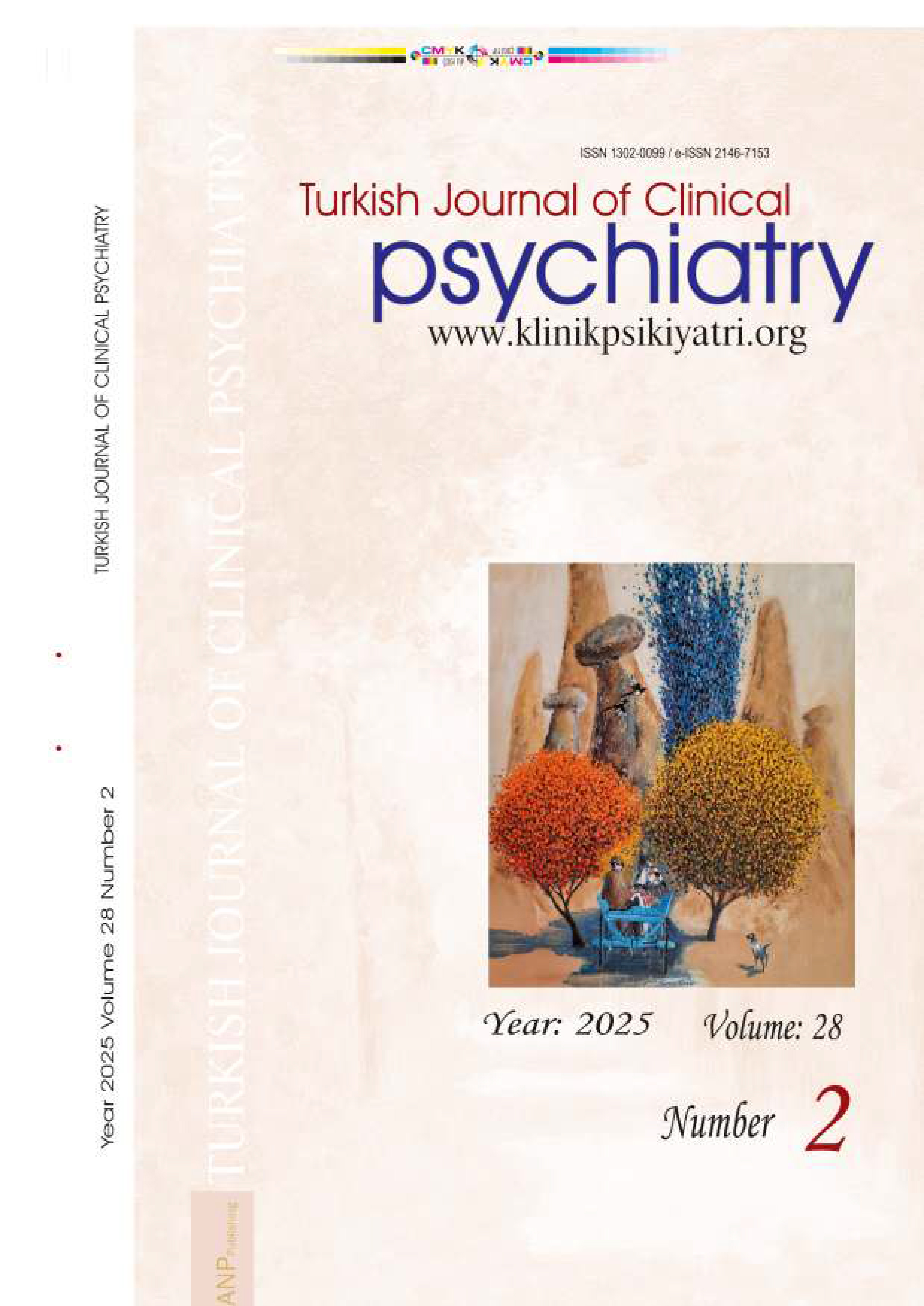





Volume: 25 Issue: 2 - 2022
| EDITORIAL | |
| 1. | The death decree of a scientific paper: Retraction (tur, eng) Mehmet Yumru, Oğuzhan Herdi doi: 10.5505/kpd.2022.35545 Pages 136 - 139 Abstract | |
| RESEARCH ARTICLE | |
| 2. | Serum zonulin levels are correlated with symptom severity independent from body mass index and gender in children with attention deficit hyperactivity disorder (eng) Miray Cetinkaya, Halil Kara, Burak Açıkel, Sibel Cigdem Tuncer doi: 10.5505/kpd.2022.74317 Pages 140 - 147 INTRODUCTION: It has been recently emphasized that neurodevelopmental disorders such as schizophrenia, autism spectrum disorder and attention deficit hyperactivity disorder (ADHD) may be related to the gut-brain axis. Zonulin is a protein that changes the integrity of tight junctions between gastrointestinal mucosa cells. We aimed to investigate serum zonulin levels and its relationship with symptom severity in children with ADHD. METHODS: 21 ADHD patients and 19 controls were included. Zonulin levels were obtained from blood specimens. Clinical severity of the ADHD symptoms was evaluated by Conner’s Parents Rating Scale-Revised/Long Form (CPRS-R/L) and Conner’s Teacher Rating Scale-Revised/Long Form (CTRS-R/L) in ADHD group. RESULTS: There was no significant difference between the groups in terms of age, gender and body mass index. Mean serum zonulin level of the ADHD group was 13.45±9.08 and 21.32± 19.96 in the control group. There was no significant difference between groups (t=1.99, p=0.51). Significant correlation was found (R=0.82, p<0.01) between serum zonulin levels and CTRS-R/L scores in the ADHD group. This correlation persisted when BMI and sex variables were controlled (R=0.85, p<0.01). DISCUSSION AND CONCLUSION: We have found significant correlation between ADHD symptom severity and serum zonulin levels, whereas there was no significant difference between children with ADHD and controls. |
| 3. | Investigation of the effect of comorbid psychopathologies on glycemic control in children and adolescents with type 1 diabetes mellitus (eng) Burcu Kardaş, Ömer Kardaş, Meliha Demiral, Edip Ünal, Mehmet Nuri Ozbek doi: 10.5505/kpd.2022.44712 Pages 148 - 154 INTRODUCTION: The presence of comorbid psychiatric conditions in chronic diseases makes the management of the disease difficult. Our study, we aimed to examine the relationship between psychiatric comorbid conditions and glycemic control in children and adolescents with Type 1 Diabetes. METHODS: In our study, depending on the number of patients, good and moderate controls were evaluated as a single group, and HbA1c levels of 8.5 and below were included in this group. Children for Depression Inventory (CDI), Screen for Child Anxiety-Related Emotional Disorders (SCARED), Turgay Child and Adolescent Behavioral Disorders Based on DSM-IV Screening and Evaluation Scale were applied. The case and parents were evaluated with K-SADS-PL.Among 778 diabetic patients who were followed up in the pediatric endocrinology clinic, 73 cases between the ages of 8 and 17 who were followed up regularly, who did not have any comorbidities and who accepted to participate in the study were evaluated psychiatrically. RESULTS: Of the 73 cases included in the study, 29 were accepted as the patients with good glycemic control (HbA1c≤8.5 mg / dl), and 44 as with poor glycemic control (HbA1c> 8.5mg / dl). In cases with poor glycemic control, parents' education level and income level were significantly lower, while the rate of attention deficit and hyperactivity disorder, major depressive disorder, social anxiety disorder and psychopathology was significantly higher. DISCUSSION AND CONCLUSION: The findings of this study revealed that there are many factors affecting glycemic control and there is a strong relationship between glycemic control and psychopathologies. |
| 4. | Relationship of clozapine serum levels with gender, smoking and symptom severity (tur) Eren Yıldızhan, Eda Uzun, Nesrin Buket Tomruk doi: 10.5505/kpd.2022.56688 Pages 155 - 167 INTRODUCTION: We planned to analyze the variations in clozapine levels with regard to gender and smoking which are variables with effects on drug metabolism in patients with psychotic disorders. METHODS: The records of patients with the diagnosis of schizophrenia and related psychotic disorders, who were attending the Community Mental Health Center (CMHC) were investigated retrospectively for clozapine serum levels and clinical features. Symptom severity at the time of the clozapine level detection was evaluated by Brief Psychiatric Rating Scale (BPRS), UKU side effects rating scale (UKU) and Personal and Social Performance Scale (PSP). Clozapine daily dose, clozapine levels, and the scores of BPRS, UKU and PSP scales were compared according to smoking habits and gender. RESULTS: There was no significant difference in clozapine dose, clozapine level and the scales of BPRS, UKU and PSP for the comparison of gender. Smoking was more frequent in males (p=0.008). Mean clozapine doses of the smoking patients were 318.1 ± 154.72 mg/day and non-smoking patients were 360.0 ± 142.98 mg/day (p>0.05). Clozapine levels of smoking patients (384.4 ± 226.80 ng/mL) were lower than non-smoking patients (835.6 ± 444.95 ng/mL) (p=0.003). The only clinical scale score which was correlated with the clozapine levels was the activation subscale of BPRS. DISCUSSION AND CONCLUSION: The possibility of clozapine levels being lower than the therapeutic dose in smoking patients and higher than safety limits in non-smoking patients should be taken into consideration. |
| 5. | Are the illness severity and treatment efficacy of the patients followed in the child psychiatry inpatient service during the pandemic period different from the ‘’Normal’’ period? (eng) Sezen Köse, Burcu Özbaran, Nurhak Doğan, İlayda Barankoğlu, Tezan Bildik doi: 10.5505/kpd.2022.46872 Pages 168 - 176 INTRODUCTION: COVID-19 pandemic poses a serious threat to health systems and inpatient treatment units. With the increase in the size of the pandemic, it has become a difficult process to carry out routine treatment services. In this study we aimed to compare the clinical profile, illness severity and length of hospitalization of the patients who were hospitalized in the child psychiatry inpatient service during the normal and the pandemic period. METHODS: The patients who were treated in the child psychiatry inpatient service during the the pandemic period (n=19), and previously normal period (n=149) were compared in terms of clinical profile, illness severity and length of hospitalization. Psychiatric diagnoses were assessed using the K-SADS-PL (Schedule for Affective Disorders and Schizophrenia for School-Age Children - Present and Lifetime Version). The Clinical Global Impressions-Severity scale (CGI-S) was applied to all patients in both groups at hospitalization and discharge point. RESULTS: We found that median level of CGI-S hospitalization scores in pandemic period was significantly higher than normal period. A significant negative correlation was found between CGI-S discharge scores and length of hospitalization during pandemic period. In addition, a significant difference was found between the groups in terms of the rate of anxiolytic drugs used. DISCUSSION AND CONCLUSION: Anxiety levels of people may increase in disasters such as pandemics, wars, earthquakes. During the pandemic period, patients with higher clinical severity of illness are treated in inpatient treatment units. In these cases, it is important to continue inpatient management without interruption, along with infection-preventive measures. |
| 6. | Comparison of emergency department and psychiatry physicians’ views on decision-making capacity cases in the grey zone (eng) Harun Olcay Sonkurt, Şengül Tosun Altınöz, Akın Coşkun, Ali Ercan Altınöz doi: 10.5505/kpd.2022.13245 Pages 177 - 183 INTRODUCTION: The aim of this study is to demonstrate the level of reconciliation between different medical branches, decision-making processes over the same facts, both among themselves and with others. METHODS: An online survey was created with three cases and six questions in the grey area related to the decision-making capacity (DMC) situations. Surveys were sent to participants through their e-mails registered in hospital systems. A total of 165 physicians participated in the study. The first scenario concerned an unstable patient with gastrointestinal bleeding and major depression requesting discharge despite medical advice. The second scenario included the discharge request of a patient who was on the border of pulmonary insufficiency with a severe asthma attack. The final scenario was about a homeless person with chest pain that occurred at the time of alcohol withdrawal, demanding discharge, at a point where a heart attack wasn’t excluded. RESULTS: 54% of psychiatry specialists, 77% of psychiatry residents, 82% of emergency medicine specialists and 76% of emergency medicine residents stated that DMC was intact for scenario 1. For scenario 2, these rates were determined as %88, %90, %76, %71 while for scenario 3 they were %44, %35, %44 and 47%, respectively. Among the psychiatrists and residents, a statistically significant difference was found between the two groups only in scenario 1. DISCUSSION AND CONCLUSION: Consistent with the literature, it was observed that the interrater agreement of DMC decisions between different medical branches was low. Differences can be explained by different experience years, educational differences, evaluating basic decision-making competencies with different degrees of importance and differences in malpractice concerns. |
| 7. | The comparison of application profile to child psychiatry outpatient clinic before and during the COVID-19 pandemic and the effect of the pandemic on emotional-behavioral problems in children (eng) Ferhat Yaylaci, Barış Güller doi: 10.5505/kpd.2022.21957 Pages 184 - 192 INTRODUCTION: This study aimed to investigate the effects of the COVID-19 pandemic and the measures taken in our country on application profile to the child psychiatry clinic. METHODS: In our study, the file data of the cases aged 0-18 years who applied to our clinic for the first time during the pandemic period (between 1st of April and 1st of august 2020) were retrospectively scanned, and they were compared with the file data of cases applying for the first time between the same dates of the previous year. As part of the evaluation, the data of the Strengths and Difficulties Questionnaire (SDQ) Parent form, which was filled out by the parents of all children between the ages of 6 and 16 who applied to our clinic for the first time, were also analyzed. RESULTS: The data of 707 children and teenagers were examined in our study. It was found that the application rate of school-aged children decreased significantly during the pandemic period (p <0.05). The rate of Anxiety Disorders (13.2%) showed a significant increase in the cases applied during the pandemic (p <0.05). The total difficulty score of SDQ was found to be significantly higher in cases with the application at the time of pandemic compared to cases that applied at the same time of the previous year. The total difficulty scores of SDQ were respectively 15.98 ± 5.63, 13.87 ± 6.64 (p <0.05). DISCUSSION AND CONCLUSION: Our findings have shown that the pandemic and the measures taken for it are the reasons for changes in the practice of child psychiatry clinics. |
| 8. | Mediterranean diet habits and their effects on symptomatology among children and adolescents with attention deficit hyperactivity disorder (eng) Mert Beşenek, Merve Yazıcı doi: 10.5505/kpd.2022.66592 Pages 193 - 201 INTRODUCTION: Attention deficit hyperactivity disorder (ADHD); is a common neurodevelopmental disorder with multifactorial etiology. Despite the dominant role of the genetic factors; environmental factors such as diet related features may have effect on ADHD diagnosis and symptomatology. In our study we aimed to compare Mediterranean diet (MD) habits of ADHD group with healthy controls and explore the effect of MD on ADHD symptom severity. METHODS: All participants were evaluated with semi-structured psychiatric interviews and total of 113 individuals with ADHD and 120 healthy controls were included. Socioeconomic and clinical features of both groups were examined. Adherence to MD was evaluated with Mediterranean Diet Quality Index (KIDMED) and ADHD symptomatology was evaluated with Turgay scale. RESULTS: ADHD group had lower KIDMED scores and worse adherence to MD compared to healthy controls. “Medium adherence” to MD increased the risk of ADHD diagnosis two-folds and “low adherence” to MD increased the risk of ADHD diagnosis five-folds compared to “good adherence”. Total KIDMED scores and MD adherence levels were negatively correlated with inattention symptoms. DISCUSSION AND CONCLUSION: Adherence to a healthy diet (MD) seems to be related to lesser inattention problems in addition to lower rates of ADHD diagnosis and this indicates the importance of a “healthy diet” not only in the occurrence of ADHD, but also in the clinical symptomatology. certain dietary habits may play a role in both ADHD development and clinical appearance; but further evaluation is needed to shed light on causality and to determine if dietary manipulation could ameliorate ADHD symptoms. |
| 9. | Evaluation of the psychiatric diagnosis of children and adolescents before and during the COVID-19 pandemic: A sample from a university hospital (tur) Hacer Gizem Gerçek, Aziz Kara, Yağmur Köksal Yasin doi: 10.5505/kpd.2022.97344 Pages 202 - 208 INTRODUCTION: The aim of this study is to determine the sociodemographic characteristics and psychiatric diagnoses of children and adolescents who refered to the psychiatry outpatient clinic during the COVID-19 pandemic. METHODS: This study enrolled the patients who were presented to the Child and Adolescent Psychiatry outpatient clinic between September 2019 and March 2020 and between September 2020 and March 2021. The patients were scanned retrospectively with the Nucleus® outpatient clinic system. The data were analyzed with SSPS 21.0. Age, gender and psychiatric diagnosis of patients were examined. RESULTS: This study enrolled 1157 patients with 10.8 mean age and 61.5% male participants. 53% (n=622) of patients was diagnosed before pandemia and 46.2% (n=535) of patients was diagnosed during pandemia. Before pandemia: patients were diagnosed with Attention Deficit Hyperactivity Disorder (ADHD) 40%, Anxiety Disorder (AD) 16.1%, Autism Spectrum Disorder (ASD) 5.1%. During pandemia: patients were diagnosed with ADHD 27.3%, AD 19.3%, ASD 5.6%. During the pandemia the number of female patients increased (p=0.017), mean age of patients decreased (p=0.035), the diagnosed ADHD rates decreased (p<0.001) and the diagnosed AD (p=0.024), Major Depressive Disorder (MDD) (p=0.001) rates increased. DISCUSSION AND CONCLUSION: In our study the diagnosis of AD and MDD during pandemia increased and the diagnosis of ADHD decreased. Because of the online education during pandemia, number of ADHD patients decreased and increasing in diagnosis of AD and MDD might caused by phsycial and social limitations. İn this period it is important to follow and treat the patients that already have psychiatric disorder like ADHD. |
| REVIEW | |
| 10. | Evaluation of the political psychological reflections of the COVID-19 process in the context of Turkey (eng) Gülşah Köprülü, Mehmet Ak doi: 10.5505/kpd.2022.16779 Pages 209 - 218 The Covid-19 epidemic, with its rapid contagion and deadly effect, emerged in China and surrounded the whole world. This epidemic, unlike other epidemics has emerged in the global age. Due to the disappearance of borders as a result of globalization, both the physiological and psychological spread of the virus has been rapid. The transmission of the Covid-19 virus through contact and droplets has provided its physiological spread, while digital media channels have provided its psychological spread. The negativities experienced in health, economy, politics and cultural structures have shaken the societies in the context of political-psychology. Anxiety and fear caused by the pandemic have negatively affected the psychology of individuals and therefore the whole society. In this study, the effects of the Covid-19 process on Turkey and how Turkey responded to the epidemic were tried to be evaluated in the context of political psychology. By examining the researches published in the process, the improvements made in the field of health against the epidemic, the regulations covering the whole society and the measures to overcome the process with the least damage were mentioned. It has been concluded that, as a result of the negative factors that directly affect mental health such as compulsory social isolation, losses, death anxiety brought by the pandemic, as well as processes such as unemployment and bankruptcy caused by inadequate socio-economic policies, a pandemic of mental disorders may occur in future. |
| CASE REPORT | |
| 11. | Myoclonic seizures induced by antipsychotic drugs: A case series and literature review (eng) Taylan Altıparmak, Cagatay Hasim Yurtseven, Bahadır Geniş, Behcet Cosar doi: 10.5505/kpd.2022.48254 Pages 219 - 222 The true frequency of myoclonic seizures caused by antipsychotics is unknown. Myoclonus associated with clozapine and other antipsychotics has been shown less frequently than tonic-clonic seizures in the literature and the treatment protocol is controversial. In this study, we have compiled current literature data by presenting our clinical experiences in patients who developed myoclonic seizures with antipsychotic use. The patients were followed up in the inpatient service of Gazi University Hospital, Department of Psychiatry between 2014-2019. Demographic data, clinical variables, imaging methods and response to treatment of 10 patients with myoclonic seizures were analyzed. After clinical evaluation, psychiatric diagnoses were clarified according to DSM-5. Psychotropic drugs and doses, EEG, MRI examinations and follow-up data were recorded in these patients with myoclonic seizures. While 6 of the patients (60%) were receiving clozapine treatment, other patients using olanzapine, amisulpride and quetiapine were seen as 2 (20%), 1 (10%) and 1 (10%), respectively. The mean chlorpromazine dose-equivalent of the antipsychotics used by all 10 patients was 876.66 mg per day. In addition to antipsychotic change, valproic acid was used (most frequently) for the control of myoclonic seizures in 8 of the patients (80%), due to insufficient response. Myoclonic seizures may be misdiagnosed as sudden falls resulting from generalized tonic-clonic seizures, dyskinesia, and clozapine induced hypotension. In patients with myoclonic seizures, use of antipsychotic drugs should be kept in mind, especially in additional medical conditions such as renal failure, as well as direct central nervous system pathologies. |
| 12. | L-carnitine use as a trigger for the onset of Kleine-Levin syndrome: A case presentation (eng) Ferhat Yaylaci, Önder Küçük, Handan Özek Erkuran doi: 10.5505/kpd.2022.91668 Pages 223 - 228 Kleine- Levin Syndrome (KLS) is a rare phenomenon characterized by repeating episodes of hypersomnia, cognitive and behavioral impairments, compulsive eating behavior, and hypersexuality. Postinfectious processes, alcohol consumption, sleep deprivation, psychological stress, getting vaccinated, head injury and genetic factors have been identified possible etiological factors. Abnormal metabolism of serotonin and dopamine have also been reported. Alcohol and cannabis have been listed among triggering factors. With its role as a mediator required to transport long-chain fatty acids to mitochondrial matrix and its contributions in increasing oxidation of fatty acids, L-carnitine helps to produce more energy from burning fat while maintaining economic use of muscle glycogen stocks. Animal studies have shown a continous increase in dopamine discharge within nucleus accumbens via acetyl L-carnitine application. Carnitine supplementation is known to cause increased dopamine levels within cortical, hippocampal and striatal regions of the rat brain. One case report reported severe psychotic symptoms in a patient with bipolar disorder, following acetyl L-carnitine use. In this case presentation, we have aimed to present clinical course of an adolescent using L-carnitine for ergogenic support, as a possible trigger for the onset of a KLS episode. |
| 13. | Approach to a case with functional gait disorder (tur) Koray Yarız, Cansu Pınar Yavaş, Hakan Kumbasar doi: 10.5505/kpd.2022.35651 Pages 229 - 233 Functional gait disorder is a common disorder seen in 8-10% of patients with psychogenic movement disorder. Many functional gait disturbances mimic neurological diseases. Astasis-abhasia, which is the most easily detected finding, is frequently observed in these patients. Patients stumble, balance momentarily and even though they seem to be in danger of falling, they always rescue themselves at the last moment and generally do not get hurt. Like all functional disorders, gait disorders can occur acutely following a psychosocial stressor. Some clues such as the fluctuating course of symptoms, abnormal slowing of movements, sudden bends in the knees and psychogenic Romberg are helpful in terms of differential diagnosis. Although the functional nature of the disorder can be recognized with careful examination, appropriate treatment of these patients requires sufficient time and effort. It is very important to establish a therapeutic relationship with the patient, to explain the relationship between symptoms and diagnosis in a plain and non-aggressive language. This functional disorder requires an individualized treatment approach. In this article, a 23-year-old female patient with mild mental retardation who presented for evaluation of complaints such as inability to stand up and walk, jerk-like movements in both arms and legs, and an abnormal posture due to continuous lateral bending is described. Clinical symptoms, possible underlying factors, treatment attempts, clinical follow-up and factors affecting the treatment success of the patient who had a complete recovery with the treatment applied in our clinic are discussed in this article. |
| 14. | Clarithromycin induced psychotic disorder with catatonic-like features in an adolescent girl: Case report (eng) Burcu Ersöz Alan, Sıla Akarçay, Yusuf Selman Çelik doi: 10.5505/kpd.2022.67984 Pages 234 - 237 Delusions and/or hallucinations developed during exposure to a medication are diagnosed medication induced psychotic disorder. Antibiotic-induced psychotic disorder have been well documented among adults. The etiology is not clear, clinical presentation is variable and catatonia-like symptoms can be seen. The prognosis is good, the symptoms decrease with the discontination of the drug, and long-term treatment is often not required. In this case, 16-year-old girl who presented with acute catatonia-like symptoms will be described. Family history of clarithromycin-induced behaviour changes accelerated the diagnosis process. Medication induced psychotic disorder should be thought in differential diagnosis of young people with acute psyhotic symptoms. |










